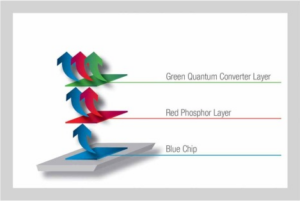Osram has developed new LEDs for TV backlighting with very high colour space coverage: the company claims that its ‘Quantum Colours’ (QC) LEDs cover 100% of DCI-P3 and more than 80% of Rec.2020.
Compared to conventional quantum dot (QD) sheets, the QC LEDs are cheaper and cadmium-free – Osram claims that costs can be halved. Dave Rousseau, product marketing manager, said, “A 55-inch TV with UltraHD 100 percent DCI coverage based on Osram Quantum Colours technology can be provided for about $58, including all the costs of the light sources. The cost of just the quantum dot sheets in existing solutions is twice as high” (based on data from NPD DisplaySearch, now IHS, in February this year).
QC LEDs are based on a green quantum converter, with a red phosphor and blue die. The technology was developed partly in the SSL4EU and Hi-Q-LED projects, funded by the EU and German Ministry of Education and Research (BMBF). LEDs using the technology have a narrow green peak, with full width half maximum of 30nm.
Another claimed advantage is in lifetime. Osram says that QD sheets develop a bluish tinge over time. By contrast, QC LEDs ‘should’ last for at least 30,000 hours. They should be in use in TVs by the end of 2016.
Analyst Comment
This is an interesting development. As we have reported several times, since 2013, Osram is working with Nanoco, so it seems reasonable to assume that the QD materials for this development are from that company. As far as we know, all of the QD developers have been working on trying to put the QD material into the LED itself, as this means that you can both get away from the expensive barrier films that you have to put on films containing QDs (as used in 3M QDEF or the Korean film used by Samsung), and you can support direct back-lit LCDs (unlike the “QDs in a tube” approach used by QD Vision). However, there are issues with heat as LEDs get very hot, internally, and the QD materials are sensitive to heat. The suggestion from the Osram graphic is that it is putting a phosphor layer between the LED device and the QDs, but we haven’t had that confirmed.
We got responses on a number of questions from Osram. The firm confirmed to us that the $58 that it quoted in its press release represents its estimated cost for a 55″ direct-lit LED-backlit LCD. The company also confirmed that the LED design is “plug & play” with its existing white LEDs without any changes to the system and would work in direct-lit or edge-lit sets.
As with other wide gamut solutions, the P3 gamut would need optimised filters, but this would be the case for any wide gamut solution, and Osram also confirmed that its choice of P3 in its release was just as an example. It could tune the green to a peak of, for example, 530 nm rather than 540nm to optimize the gamut to maximise the Rec. 2020 coverage.
Osram also confirmed that it has testing samples now, with LED samples available to customers in the Spring of 2016 and mass production towards the end of the year. (BR)
Article updated to reflect responses from Osram (3rd December 2015)

